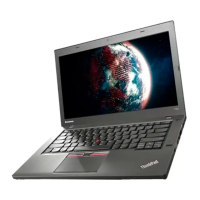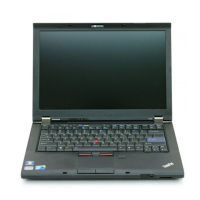











Do you have a question about the Lenovo ThinkPad T430 and is the answer not in the manual?
Guidelines to prevent injury from computer heat and protect from liquid spills.
Safe practices for moving, handling, and carrying the computer to prevent damage.
How to identify and respond to hazardous conditions and general safety precautions.
Identifies physical components like ports, buttons, speakers, and indicators on the computer.
How to manage battery power, check status, and use the AC adapter efficiently.
Setting and managing power-on, hard disk, and supervisor passwords for system protection.
Securing storage drives with passwords and using BitLocker Drive Encryption.
Configuring security chip settings and using fingerprint reader for system access.
Information on restoring Windows 7 systems, creating recovery media, and backups.
How to refresh or reset the computer to factory default settings on Windows 8.
Step-by-step guides for replacing battery, hard disk, keyboard, memory, and wireless cards.
Navigating the ThinkPad Setup utility to configure BIOS and system parameters.
Using Lenovo Solution Center and general troubleshooting steps for common problems.
Solutions for specific issues like blank screens, error messages, and boot problems.
Guidelines to prevent injury from computer heat and protect from liquid spills.
Safe practices for moving, handling, and carrying the computer to prevent damage.
How to identify and respond to hazardous conditions and general safety precautions.
Identifies physical components like ports, buttons, speakers, and indicators on the computer.
How to manage battery power, check status, and use the AC adapter efficiently.
Setting and managing power-on, hard disk, and supervisor passwords for system protection.
Securing storage drives with passwords and using BitLocker Drive Encryption.
Configuring security chip settings and using fingerprint reader for system access.
Information on restoring Windows 7 systems, creating recovery media, and backups.
How to refresh or reset the computer to factory default settings on Windows 8.
Step-by-step guides for replacing battery, hard disk, keyboard, memory, and wireless cards.
Navigating the ThinkPad Setup utility to configure BIOS and system parameters.
Using Lenovo Solution Center and general troubleshooting steps for common problems.
Solutions for specific issues like blank screens, error messages, and boot problems.
| LED backlight | Yes |
|---|---|
| Display diagonal | 14 \ |
| Display resolution | 1600 x 900 pixels |
| Native aspect ratio | 16:9 |
| Memory slots | 2x SO-DIMM |
| Internal memory | 4 GB |
| Memory clock speed | 1600 MHz |
| Internal memory type | DDR3-SDRAM |
| Maximum internal memory | 16 GB |
| Memory slots (available) | 1 |
| Memory layout (slots x size) | 1 x 4 GB |
| Bus type | DMI |
| Stepping | L1 |
| Tjunction | 105 °C |
| Processor cache | 3 MB |
| Processor cores | 2 |
| Processor model | i5-3320M |
| System bus rate | 5 GT/s |
| Processor family | Intel® Core™ i5 |
| Processor series | Intel Core i5-3300 Mobile series |
| Processor socket | BGA 1023 |
| Processor threads | 4 |
| Processor codename | Ivy Bridge |
| Processor frequency | 2.6 GHz |
| Processor cache type | Smart Cache |
| Processor lithography | 22 nm |
| Processor manufacturer | Intel |
| Processor front side bus | - MHz |
| PCI Express slots version | 3.0 |
| Processor boost frequency | 3.3 GHz |
| Processor operating modes | 64-bit |
| PCI Express configurations | 1x16, 2x8, 1x8+2x4 |
| Thermal Design Power (TDP) | 35 W |
| CPU multiplier (bus/core ratio) | 26 |
| Maximum number of PCI Express lanes | 16 |
| Motherboard chipset | - |
| Intel segment tagging | Home Office, Small Business |
| SSD capacity | The Solid State Drive's storage capacity in Gigabytes. |
| Storage media | SSD |
| Optical drive type | DVD±RW |
| Total storage capacity | 128 GB |
| Compatible memory cards | MMC, SD, SDHC, SDXC |
| On-board graphics card ID | 0x166 |
| Discrete graphics card model | Not available |
| On-board graphics card model | Intel® HD Graphics 4000 |
| On-board graphics card family | Intel® HD Graphics |
| On-board graphics card base frequency | 650 MHz |
| On-board graphics card dynamic frequency (max) | 1200 MHz |
| Optical drive interface | SATA |
| Audio system | Dolby Advanced Audio 2.0 |
| WWAN | Installed |
| Wi-Fi standards | 802.11b, 802.11g, Wi-Fi 4 (802.11n) |
| Cabling technology | 10/100/1000Base-T(X) |
| Networking features | Gigabit Ethernet, WLAN, WWAN |
| Ethernet LAN data rates | 10, 100, 1000 Mbit/s |
| Mobile network generation | 3G |
| Charging port type | DC-in jack |
| Headphone connectivity | 3.5 mm |
| USB 2.0 ports quantity | USB 2.0 ports have a data transmission speed of 480 Mbps, and are backwards compatible with USB 1.1 ports. You can connect all kinds of peripheral devices to them. |
| eSATA/USB 2.0 ports quantity | 0 |
| Keyboard layout | QWERTY |
| Pointing device | Touchpad |
| Operating system installed | Windows 7 Professional |
| Form factor | Clamshell |
| Product type | Laptop |
| Product color | Black |
| Battery life (max) | 9.7 h |
| Number of battery cells | 6 |
| AC adapter frequency | 50 - 60 Hz |
| Cable lock slot type | Kensington |
| Password protection type | HDD, Power on, Supervisor |
| Cables included | AC |
| Sustainability certificates | ENERGY STAR |
| Processor code | SR0MY |
| Processor ARK ID | 64896 |
| Processor package size | 37.5 x 37.5 (rPGA988B); 31.0 x 24.0 (BGA1023) mm |
| Supported instruction sets | AVX |
| Intel Identity Protection Technology version | 1.00 |
| Depth | 232 mm |
|---|---|
| Width | 340 mm |
| Height | 30 mm |
| Weight | 2170 g |











